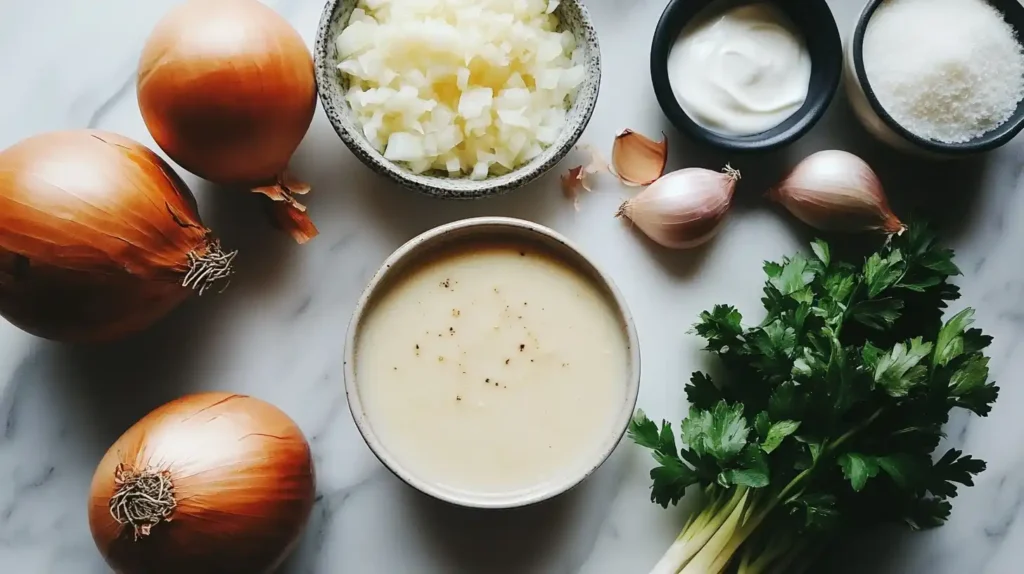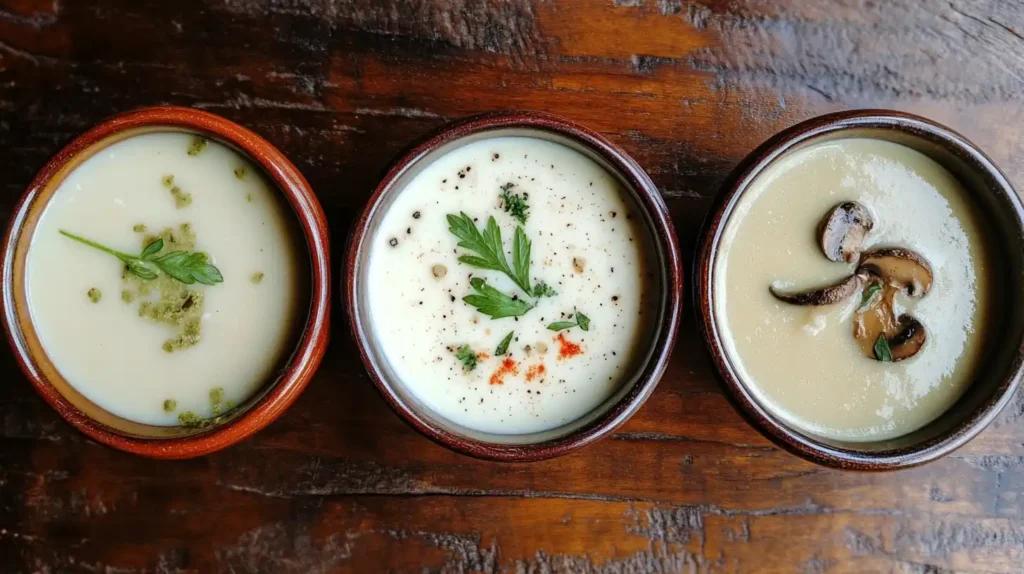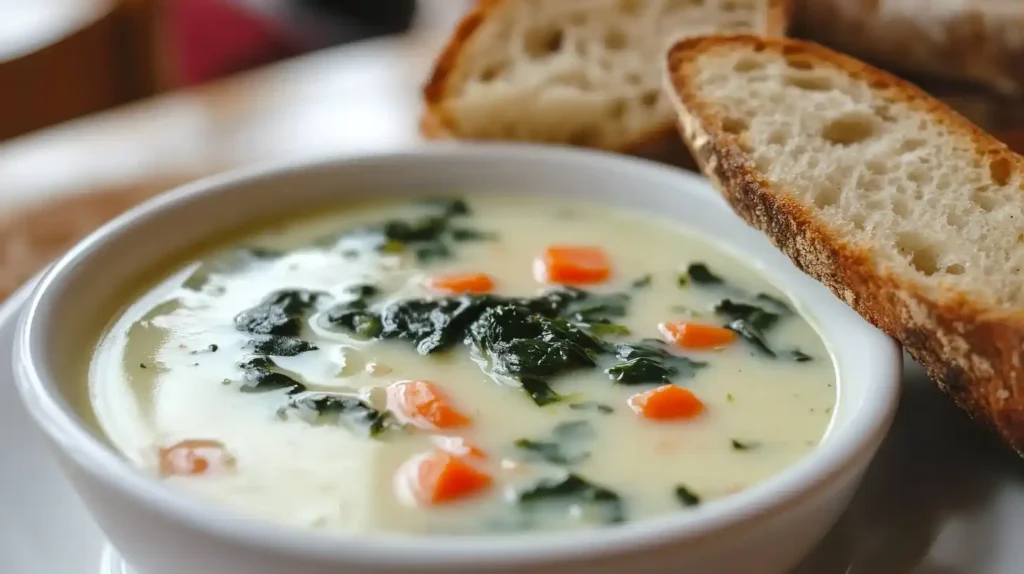Cream soup is a beloved dish that is both hearty and comforting. It blends simple ingredients to achieve a rich, smooth texture that everyone enjoys. Popular varieties like cream of mushroom, cream of chicken, and cream of broccoli are staples in many kitchens. These soups can be enjoyed as a meal or used as a base in recipes. But have you ever stopped to think about what actually goes into a cream of soup? Understanding its key components and how they work together can help you make this dish at home with ease.
Table of contents
- What is Cream of Soup?
- Ingredients That Define Cream Soup (Ingredients of cream soup)
- The Origins of Cream Soup
- Steps to Make Cream Soup at Home: A Cream Soup Recipe Guide (How to Make Cream of Soup)
- Cultural Variations of Cream Soup
- Health and Nutritional Considerations for Cream Soup
- Common Uses for Cream Soup
- Frequently Asked Questions
- Conclusion

This guide will walk you through everything you need to know about cream soups, from their ingredients to the cooking process.
What is Cream of Soup?
A cream of soup is a thick and smooth dish made by blending a few simple ingredients into a rich, velvety mixture. It usually includes cream, stock, and a main ingredient, such as mushrooms, broccoli, or chicken. The cream, which can be heavy cream or a dairy-free alternative, is what gives the soup its signature texture and flavor.
Additionally, the base of the soup often contains aromatics like onions, garlic, and celery to build depth. A thickening agent, such as a roux made from butter and flour, helps the soup achieve its luscious consistency. Because of its versatility, cream of soup is a favorite worldwide. You can serve it on its own or use it as a base in other recipes, like casseroles and sauces.
For a more detailed explanation of its origins and ingredients, you can explore this Wikipedia page on cream soups. It offers great insights into how these soups became so popular.
Ingredients That Define Cream Soup (Ingredients of cream soup)
Every cream soup depends on essential ingredients that blend to achieve its distinctive flavor and texture. By combining these components thoughtfully, you can make a soup that is both delicious and versatile. Here’s a breakdown of the main ingredients:
1. Aromatics
Aromatics, such as onions, garlic, and celery, provide the foundation for the soup’s flavor. They are typically sautéed in butter to release their natural sweetness, which adds depth to the dish. This step is important because it ensures that the base of your soup is flavorful and aromatic.
2. Main Ingredient
The key component of any cream soup is its primary ingredient, which determines its flavor. Common choices include mushrooms, broccoli, potatoes, or chicken. The main ingredient is often cooked until tender before being blended into the soup for a smooth texture.
3. Thickening Agent
A thickening agent provides cream soups with their characteristic smooth and velvety texture. Most recipes use a roux, which is a simple mixture of butter and flour cooked together. For those who need a gluten-free option, cornstarch works as an excellent substitute.
4. Stock
Stock serves as the liquid base of the soup, adding both flavor and volume. Chicken stock is the most common choice, but vegetable stock works well for vegetarian versions. The stock is often simmered with the other ingredients to meld the flavors together.
5. Cream
Finally, cream is what makes the soup truly indulgent. Heavy cream is a classic choice, but milk or dairy-free substitutes like coconut milk can also be used. Adding cream at the end of cooking ensures the soup remains smooth and does not curdle.
The Origins of Cream Soup
The history of cream of soup is as rich as its texture. It originates from French cuisine, where chefs developed it as part of the velouté sauce, one of the five mother sauces. Over time, these velvety soups became a symbol of sophistication in both European and American kitchens.
In the late 19th and early 20th centuries, cream soups gained widespread popularity, thanks to innovations in food production. Companies like Campbell’s introduced condensed soups, such as cream of mushroom and cream of chicken. These products were easy to prepare and versatile, making them an instant hit among home cooks.
Interestingly, the name “cream of” soup refers to the blending of cream or milk into the base. This method gives the soup its smooth consistency while allowing the flavors of the main ingredient to shine. The process quickly became a culinary standard and paved the way for modern recipes we enjoy today.
Steps to Make Cream Soup at Home: A Cream Soup Recipe Guide (How to Make Cream of Soup)
Making a homemade cream of soup is much simpler than you might think. By following a few easy steps, you can create a dish that is both delicious and satisfying. Whether you’re preparing it for a cozy dinner or as a base for another recipe, this process will guide you.
Step 1: Prepare the Aromatics
Start by heating butter in a large pot over medium heat. Once melted, sauté onions, garlic, and celery until they become soft and fragrant. This step is crucial because it builds the foundation for the soup’s flavor.
Step 2: Add the Main Ingredient (Cream soup components)
Next, add your main ingredient, such as mushrooms, broccoli, or chicken. Cook until the ingredient is tender and has released its flavors into the pot. For instance, mushrooms will shrink slightly and become aromatic as they cook.
Step 3: Create the Roux
Once the main ingredient is cooked, sprinkle flour over the mixture. Stir continuously to create a roux, which thickens the soup. Be careful not to let the roux burn, as this can affect the final flavor.
Step 4: Pour in the Stock
Slowly add chicken or vegetable stock while whisking to avoid lumps. Allow the mixture to simmer for a few minutes, which helps the flavors meld together beautifully.
Step 5: Blend the Soup (Cream soup recipe guide)
Use an immersion blender to puree the soup until it becomes smooth. If you don’t have one, transfer the mixture to a countertop blender in small batches. Be cautious while blending hot liquids.
Step 6: Add the Cream
Finally, stir in heavy cream or a non-dairy alternative. Let the soup heat gently, but avoid boiling, as this can cause the cream to separate. Add salt, pepper, and any extra spices to suit your taste.
Cultural Variations of Cream Soup
One of the most exciting aspects of cream of soup is its ability to adapt to different cuisines. Around the world, chefs have added their unique touches to this classic dish, resulting in a variety of delicious interpretations. These cultural twists make cream soup a versatile and beloved option for countless meals.

French Cream Soups (Cream soup basics)
In French cuisine, cream soups are often elegant and refined. For instance, cream of asparagus and cream of leek are popular choices. These soups typically include fresh herbs like thyme or parsley, which add subtle flavor without overpowering the dish.
American Cream Soups (Cream soup components)
In the United States, cream soups are both a meal and an essential ingredient in other recipes. Cream of mushroom and cream of chicken soups are widely used in casseroles, providing a creamy texture and rich taste. Additionally, the convenience of condensed versions has made them a pantry staple for many households.
Asian-Inspired Variations (How to make cream of soup)
In Asian cuisines, cream soups often feature coconut milk instead of dairy cream. This substitution adds a unique sweetness and a lighter texture. Ingredients like ginger, lemongrass, or curry spices are frequently included, creating bold and exciting flavors.
Why Do Cultures Love Cream Soups?
Across different cuisines, cream soups are favored because they combine comfort with sophistication. They can be served as a standalone dish or incorporated into other meals, making them incredibly flexible.
Health and Nutritional Considerations for Cream Soup
Cream soups are undeniably comforting, but their nutritional value largely depends on how they are made. By carefully selecting ingredients, you can enjoy a cream of soup that fits into a healthy lifestyle. Here’s what to consider:
Calorie Content
Traditional cream soups can be calorie-dense because they often use heavy cream and butter. However, there are many ways to make lighter versions. For example, swapping heavy cream for milk or non-dairy alternatives, such as almond or oat milk, significantly reduces the calorie count.

Dietary Restrictions
For those with dietary restrictions, cream soups can be adapted to suit specific needs:
- Gluten-Free Options: Replace the flour in the roux with cornstarch or another gluten-free thickener.
- Dairy-Free Choices: Use coconut milk, cashew cream, or almond milk instead of dairy cream.
Boosting Nutritional Value
Adding vegetables or lean proteins can make cream soups healthier. For instance, blending spinach, carrots, or even lentils into the soup increases its fiber and nutrient content without compromising flavor.
Portion Control
Because cream soups are rich, enjoying them in moderate portions can help you balance your diet. Pairing the soup with a fresh salad or whole-grain bread can also create a more complete meal.
Common Uses for Cream Soup
Cream soups are not just a delicious meal on their own—they also serve as versatile ingredients in a variety of dishes. Whether you are looking for a hearty main course or a way to enhance another recipe, cream soups can be a go-to option. Here are some of their most common uses:
1. As a Standalone Dish
Cream soups, like cream of mushroom or cream of broccoli, make excellent starters or light meals. Adding a slice of crusty bread or a simple side salad can turn them into a satisfying lunch or dinner.
2. As a Casserole Base
In the kitchen, cream soups shine as the foundation for many casseroles. For instance, cream of mushroom soup is a classic ingredient in green bean casserole. The soup binds the ingredients together while adding a creamy texture and flavor.
3. As a Sauce Substitute
Cream soups work well as a substitute for cream-based sauces. You can pour them over baked vegetables, mix them with pasta, or even use them as a topping for baked chicken. This versatility makes them a great time-saver when cooking.
4. As a Dip
When thickened slightly, cream soups can be transformed into dips. For example, cream of spinach soup can become a flavorful dip for crackers, bread, or raw vegetables.
Why Are Cream Soups So Versatile?
Because cream soups combine a mild flavor with a creamy texture, they can be used in countless ways. Their ability to blend with other ingredients makes them a staple in both home cooking and professional kitchens.
Frequently Asked Questions
To wrap up this exploration of cream of soup, let’s address some frequently asked questions. These queries often come up when people are learning about or making cream soups.
1. What Are Cream Soups Made Of? (Cream Soup Components)
Cream soups typically include a combination of aromatics, such as onions and garlic, a main ingredient like mushrooms or broccoli, a thickening agent, stock, and cream. These ingredients blend together to create a smooth, velvety soup.
2. Why Are They Called “Cream Of” Soups?
The name “cream of” refers to the use of cream or milk in the recipe, which gives the soup its signature rich texture. Additionally, it highlights the main ingredient, such as mushrooms or chicken, which defines the flavor.
3. Are Cream Soups Healthy?
Cream soups can be healthy, but it depends on how they are made. Traditional recipes using heavy cream and butter are richer, but lighter versions with milk or plant-based substitutes can be just as delicious. Adding vegetables and lean proteins also boosts their nutritional value.
4. What Are the Three Main Elements of a Cream Soup? (Ingredients of cream soup)
The three essential elements are:
- Aromatics: To build flavor.
- Stock: To serve as the liquid base.
- Cream: To provide the soup’s rich, smooth texture.
5. Can Cream Soups Be Made Without Dairy?
Yes, cream soups can be made dairy-free. Substitutes like coconut milk, almond milk, or cashew cream provide similar textures while catering to dietary restrictions.
By understanding these basics, you’ll feel more confident in cooking or experimenting with cream soups at home. If you want to dive deeper into their preparation, refer to this comprehensive cream soup guide.
Conclusion
Cream soups are more than just a comforting meal—they are a testament to the art of combining simple ingredients to create something extraordinary. Their creamy texture, rich flavors, and incredible versatility have earned them a special place in kitchens worldwide.
Whether you enjoy cream soups on their own, use them as a base for casseroles, or turn them into a flavorful sauce, they never fail to deliver. Additionally, the ability to customize them with different ingredients, dietary substitutions, or cultural twists makes them an essential recipe for home cooks and professional chefs alike.
By understanding what goes into a cream of soup and how to prepare it, you can confidently create your own versions that suit your taste and needs. So, why not experiment with a homemade cream soup today? You might discover a new favorite dish that brings both comfort and joy to your table.

